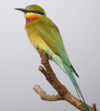INTRODUCTION

 For at least 10 years we have considered Fuerteventura for a short burst of winter sunshine. This year, at long last, we took the plunge: not many lifers on offer, but some relaxed birding along the island’s many tracks sounded like a good idea. Timing could not have been better as the weather system nicknamed the “Beast from the East” combined with storm Emma to create some of the most testing weather experienced in the UK for years..... we missed it all!
For at least 10 years we have considered Fuerteventura for a short burst of winter sunshine. This year, at long last, we took the plunge: not many lifers on offer, but some relaxed birding along the island’s many tracks sounded like a good idea. Timing could not have been better as the weather system nicknamed the “Beast from the East” combined with storm Emma to create some of the most testing weather experienced in the UK for years..... we missed it all!
LOGISTICS
A visit to Hays Travel cut through the numerous options we were finding on the internet and within 20 minutes we had booked our package and looking forward to flying off to the sun five weeks later.
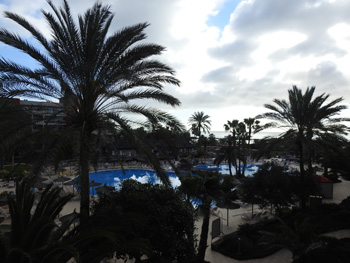 We arranged car hire ourselves through Rentalcars.com and ended up with a VW Tiguan 4WD from Sixt which we picked up at the airport for the 10 minute trip to our hotel, the Elba Carlota in Castillo Caleta de Fuste. Whilst we were there and carrying our fleeces to go birdwatching, as a protection against the fierce wind, it was obvious that most hotel guests were sheltered by the bulk of the buildings and the planting that surrounded them. Sunbeds proved very popular and lots of people were sporting either a nice sun tan or a ruddy sunburn. The Elba Carlota was very comfortable; the staff were multi-lingual, good humoured and very helpful. Our package was based on half-board and as far as we could see, all meals were buffet style. The hotel is large with a lot of people to feed: a wide range of food provided a more than adequate choice for all the guests’ requirements.
We arranged car hire ourselves through Rentalcars.com and ended up with a VW Tiguan 4WD from Sixt which we picked up at the airport for the 10 minute trip to our hotel, the Elba Carlota in Castillo Caleta de Fuste. Whilst we were there and carrying our fleeces to go birdwatching, as a protection against the fierce wind, it was obvious that most hotel guests were sheltered by the bulk of the buildings and the planting that surrounded them. Sunbeds proved very popular and lots of people were sporting either a nice sun tan or a ruddy sunburn. The Elba Carlota was very comfortable; the staff were multi-lingual, good humoured and very helpful. Our package was based on half-board and as far as we could see, all meals were buffet style. The hotel is large with a lot of people to feed: a wide range of food provided a more than adequate choice for all the guests’ requirements.

 With good roads all around the island, getting about was straightforward aided by the Fuerteventura Super-Durable Map
With good roads all around the island, getting about was straightforward aided by the Fuerteventura Super-Durable Map and site instructions, principally from the Canary Islands: Vol. 1: Fuerteventura and Lanzarote - Spain (Crossbill Guide) and Finding Birds in the Canaries
and site instructions, principally from the Canary Islands: Vol. 1: Fuerteventura and Lanzarote - Spain (Crossbill Guide) and Finding Birds in the Canaries by Dave Gosney. We also used A Birdwatchers' Guide to the Canary Islands (Prion Birdwatchers' Guide Series)
by Dave Gosney. We also used A Birdwatchers' Guide to the Canary Islands (Prion Birdwatchers' Guide Series) by Tony Clarke and David Collins: this book is now a little dated – the sites still remain but access/road descriptions have changed substantially in some cases. There are also plenty of trip reports and information available on the internet via Cloudbirders and Fat Birder web sites.
by Tony Clarke and David Collins: this book is now a little dated – the sites still remain but access/road descriptions have changed substantially in some cases. There are also plenty of trip reports and information available on the internet via Cloudbirders and Fat Birder web sites.
Rather than give full directions to each site, unless there have been significant changes, the relevant pages in either “Gosney” or “Crossbill Guide” will be referred to eg (G px-x: C px-x).

 A useful summary of birding sites cross-referencing all the available sources was drawn up by Kilian Wasmer in 2015 and can be found online.
A useful summary of birding sites cross-referencing all the available sources was drawn up by Kilian Wasmer in 2015 and can be found online.
The specialist bird books for the area are Birds of the Canary Islands (Helm Field Guides) by Eduardo Garcia-del-Rey and A Field Guide to the Birds of the Atlantic Islands: Canary Islands, Madeira, Azores, Cape Verde (Helm Field Guides)
by Eduardo Garcia-del-Rey and A Field Guide to the Birds of the Atlantic Islands: Canary Islands, Madeira, Azores, Cape Verde (Helm Field Guides) by Tony Clarke and Chris Orgill. However, if you already have Collins Bird Guide
by Tony Clarke and Chris Orgill. However, if you already have Collins Bird Guide , you don’t really need much else.
, you don’t really need much else.
DIARY
Monday 26th February
Our flight from Manchester was delayed for an hour as a result of weather problems in the Canaries the previous day. We arrived at our hotel around 16.30, unpacked and went for a stroll along the sea front promenade to stretch our legs before dinner (G p24). On the rocky foreshore we saw single Redshank, Ringed Plover and Little Egret, together with a pair of Turnstone and several Yellow-legged Gull. The sunshine, 20°C and warm, stiff breeze were a welcome change from the freezing weather we had left behind in the UK.
Tuesday 27th February
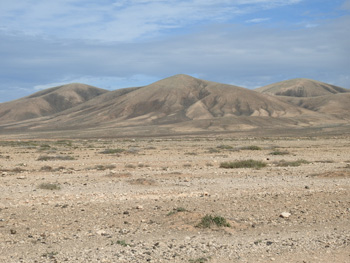 After a leisurely breakfast we left the hotel in a fruitless search to purchase an adaptor we had left at home and as a result only arrived at our first birding destination, Tindaya, around 12.00 (G p28-3: C p124-1). The stony plains and sparse vegetation stretched out before us as we left the town heading east, towards the coast on a tarmac road with numerous potholes, reminding us of home! Several tracks crossed our path as we drove onwards, stopping regularly to scan the stony ground with wildlife almost nowhere to be seen. This theme was to repeat itself throughout our trip with lots of “lbjs” flying nearby and immediately going to ground and instant cover.
After a leisurely breakfast we left the hotel in a fruitless search to purchase an adaptor we had left at home and as a result only arrived at our first birding destination, Tindaya, around 12.00 (G p28-3: C p124-1). The stony plains and sparse vegetation stretched out before us as we left the town heading east, towards the coast on a tarmac road with numerous potholes, reminding us of home! Several tracks crossed our path as we drove onwards, stopping regularly to scan the stony ground with wildlife almost nowhere to be seen. This theme was to repeat itself throughout our trip with lots of “lbjs” flying nearby and immediately going to ground and instant cover.
On the Tindaya track we managed to eventually ID 2 Trumpeter Finch and 4 Berthelot’s Pipits plus a single Spectacled Warbler, whilst a Common Kestrel and 2 Raven provided regular company. After about an hour and a half, as we drove back to the town and just before the “road” crossed the track to El Cotillo, a male Houbara Bustard suddenly appeared majestically at the side of the road. We watched, entranced, as the bird picked about in the roadside scrub, crossed in front of the vehicle, and wandered away north-east. What a start to our trip!

 Encouraged, we drove onwards towards El Cotillo with just Ravens and a few Pipits for company. As the semi-desert gave way to a barranco lined with Canary Tamarisks (C p125-3), we turned left to stay on the coastal track and almost immediately had fleeting views of 2 Barbary Partridge as they scurried across the track in front of us. At this point the track follows the bed of the barranco and can become impassable after heavy rains; we were certainly glad we had a 4WD in places. The steppe plain towards El Cotillo was almost devoid of birds: we did however see our first of many Barbary Ground Squirrel.
Encouraged, we drove onwards towards El Cotillo with just Ravens and a few Pipits for company. As the semi-desert gave way to a barranco lined with Canary Tamarisks (C p125-3), we turned left to stay on the coastal track and almost immediately had fleeting views of 2 Barbary Partridge as they scurried across the track in front of us. At this point the track follows the bed of the barranco and can become impassable after heavy rains; we were certainly glad we had a 4WD in places. The steppe plain towards El Cotillo was almost devoid of birds: we did however see our first of many Barbary Ground Squirrel.
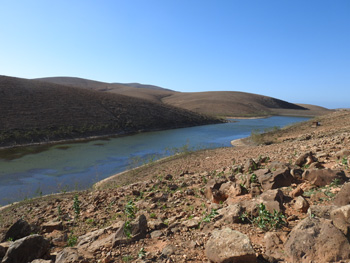 From El Cotillo we went to Los Molinos reservoir, via La Oliva, arriving around 15.30 (G p26-2: C p131-4). The wind strength seemed to increase as the day went on and by late afternoon we struggled to use our telescope around the dam, but walking the length of the reservoir on the trail, accessed via the gate on the edge of the parking area, we managed to add several new species to our slowly expanding list. The Coot and other birds on the water suddenly took flight as a Barbary Falcon flew past and eventually landed on what appeared to be a favoured perching post; a small, spindly, leafless tree on the other side of the reservoir, just above the water line. Despite the wind, we managed good scoped views of the bird, which remained there for about 30 minutes. As well as a small flock of Teal and c40 Little Egret, roosting on the slopes above the reservoir on the opposite bank, we saw 4 Grey Heron, 4 Spoonbill, numerous Black-winged Stilt, Trumpeter Finch, Ruddy Shellduck and Yellow-legged Gull, with a single Green Sandpiper and 3 Marbled Duck at the southern end of the reservoir where the barranco enters the dam. Driving back from the dam to the main road we noticed two Raven mobbing two much larger birds: Egyptian Vultures which soared around overhead for a few minutes, giving excellent views, a little over 10 metres above our heads. On the road to Tefia we spotted a pair of Plain Swift, 2 male Kestrel and a lone Buzzard, perched on the roadside wires.
From El Cotillo we went to Los Molinos reservoir, via La Oliva, arriving around 15.30 (G p26-2: C p131-4). The wind strength seemed to increase as the day went on and by late afternoon we struggled to use our telescope around the dam, but walking the length of the reservoir on the trail, accessed via the gate on the edge of the parking area, we managed to add several new species to our slowly expanding list. The Coot and other birds on the water suddenly took flight as a Barbary Falcon flew past and eventually landed on what appeared to be a favoured perching post; a small, spindly, leafless tree on the other side of the reservoir, just above the water line. Despite the wind, we managed good scoped views of the bird, which remained there for about 30 minutes. As well as a small flock of Teal and c40 Little Egret, roosting on the slopes above the reservoir on the opposite bank, we saw 4 Grey Heron, 4 Spoonbill, numerous Black-winged Stilt, Trumpeter Finch, Ruddy Shellduck and Yellow-legged Gull, with a single Green Sandpiper and 3 Marbled Duck at the southern end of the reservoir where the barranco enters the dam. Driving back from the dam to the main road we noticed two Raven mobbing two much larger birds: Egyptian Vultures which soared around overhead for a few minutes, giving excellent views, a little over 10 metres above our heads. On the road to Tefia we spotted a pair of Plain Swift, 2 male Kestrel and a lone Buzzard, perched on the roadside wires.
Although it was sunny all day, winds gusting to 36 kmph kept temperatures down to a very manageable 20-23°C.
Wednesday 28th February
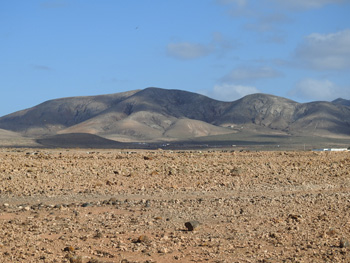 With rain forecast all morning we decided to head south for some different habitat around the western part of La Jandia. We started off at La Pared around 10.15 with the heavy rain we had experienced on the journey giving way to a more benevolent drizzle (G p32-4). From the town we followed the signs to Bahia La Pared and started off parked by the restaurant at the end of the road. We back-tracked a short distance and parked at the side of the road, overlooking several small pools in the stream. The rain persisted but we were able to watch a single Ringed Plover, 4 Little Ringed Plover, Ruddy Shelduck, single Common Sandpiper and White Wagtail in and around the pools, whilst Willow Warbler flitted about in the Tamarisks which lined the small stream.
With rain forecast all morning we decided to head south for some different habitat around the western part of La Jandia. We started off at La Pared around 10.15 with the heavy rain we had experienced on the journey giving way to a more benevolent drizzle (G p32-4). From the town we followed the signs to Bahia La Pared and started off parked by the restaurant at the end of the road. We back-tracked a short distance and parked at the side of the road, overlooking several small pools in the stream. The rain persisted but we were able to watch a single Ringed Plover, 4 Little Ringed Plover, Ruddy Shelduck, single Common Sandpiper and White Wagtail in and around the pools, whilst Willow Warbler flitted about in the Tamarisks which lined the small stream.
Driving back from La Pared we took the track signed Pueblo del Mar with the intention of crossing the Istmo de la Pared desert area on our way to Costa Calma (G p32-3). Even with our 4WD the track became impassable after a few kilometres so we executed a “several-point” turn and bumped our way slowly back to the main road. A couple of Berthelot’s Pipits and Lesser Short-toed Lark put in an appearance before we left the area, but there was no sign of any of the more desirable desert species. We tried to find the other end of the desert track from Costa Calma, but the new dual carriageway which by-passes the town now appears to have cut off all access to the tracks described in Gosney.
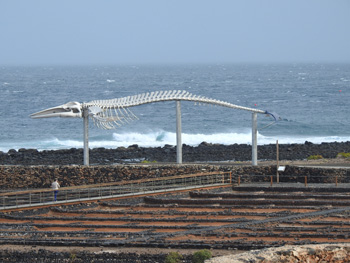 By 11.30 we were enjoying sunshine again as parked up at the southern end of Costa Calma overlooking the tidal lagoons (G p30-4: C p140-3). With the tide coming in and numerous kite-surfers off-shore we wandered out along the edge of the lagoons for excellent views of c20 Whimbrel accompanied by a single Bar-tailed Godwit. Two Little Egret and several elusive “lbjs” were all we saw in addition, with at least 4 Barbary Ground Squirrel skittering around our parked car.
By 11.30 we were enjoying sunshine again as parked up at the southern end of Costa Calma overlooking the tidal lagoons (G p30-4: C p140-3). With the tide coming in and numerous kite-surfers off-shore we wandered out along the edge of the lagoons for excellent views of c20 Whimbrel accompanied by a single Bar-tailed Godwit. Two Little Egret and several elusive “lbjs” were all we saw in addition, with at least 4 Barbary Ground Squirrel skittering around our parked car.
We drove further south on the FV2 to Morro Jable (G p30-5: C p142-5), arriving c 13.45 to the sight of Rose-ringed and Monk Parakeet feeding on sunflower seeds from the hands of passing tourists at the edge of a children’s play area near the lighthouse and opposite the abandoned zoo. Spanish Sparrow and an opportunistic Berthelot’s Pipit enjoyed the left-overs on the ground. The feral colonies of parakeets in the palm trees surrounding the zoo are quite raucous and leave the pavements and walls under the trees covered in pungent guano: an ideal tourist attraction! Also a relic of the zoo, we saw a single Hadada Ibis and 2 Sacred Ibis as we watched numerous small birds flitting about in the thick vegetation of the zoo grounds and frequenting a small pool under a dripping water pipe. A pair of Blackcap, at least 3 Chiffchaff and a similar number of Blue Tit took our minds off the guano. Walking back from a bird-less trip to the lighthouse we saw c3 Plain Swift around the resort buildings.
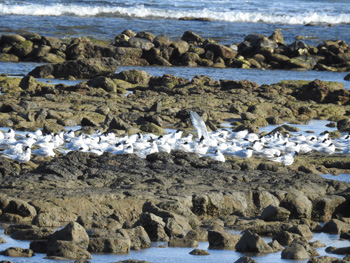 Leaving Morro Jable c14.30 we headed north on the FV2, but before returning to our hotel we stopped at the saltpans - Salinas de El Carmen (G p24-4: C p148 E) where we had a flock of c100 Sandwich Tern, 7 Spoonbill, 4 Whimbrel and single Little egret and Gannet. Next came the nearby Barranco de la Torre (G p24-5: C p148 F) where we saw our first pair of Fuerteventura Chat, single Buzzard, Raven and Spectacled Warbler. Just before reaching Caleta de Fuste we turned off the road at an island on to a track leading to the shore and picked up a Greenshank, Sanderling and a pair of Kentish Plover.
Leaving Morro Jable c14.30 we headed north on the FV2, but before returning to our hotel we stopped at the saltpans - Salinas de El Carmen (G p24-4: C p148 E) where we had a flock of c100 Sandwich Tern, 7 Spoonbill, 4 Whimbrel and single Little egret and Gannet. Next came the nearby Barranco de la Torre (G p24-5: C p148 F) where we saw our first pair of Fuerteventura Chat, single Buzzard, Raven and Spectacled Warbler. Just before reaching Caleta de Fuste we turned off the road at an island on to a track leading to the shore and picked up a Greenshank, Sanderling and a pair of Kentish Plover.
Thursday 1st March
Heading north from Caleta de Fuste, we took the FV413 at the first roundabout, heading west towards Antigua and then north through Triquivijate on the FV430. Just over 5km from the town, heading north, there is a pool, half surrounded by reeds, at the side of the road on the left with a convenient pull-off and opposite a sign for Altaya de la Rosa del Taro, one of the highest peaks nearby (G p20-2). The pool has resident Coot and Moorhen, but you never know what may drop in – a single Tufted Duck was there on this visit.
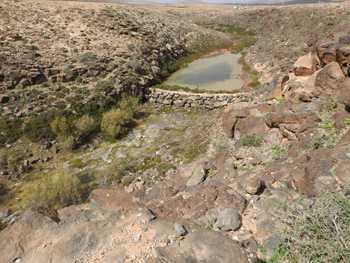 Continuing north to the FV20 we saw at least 4 Raven, Kestrel, Buzzard and 2 Egyptian Vulture with all of the latter species being fairly common in this area. Our next destination was Llanos Pelados; or to be more precise the small dams in the upper reaches of Barranco de Rio Cabras (C p132-2) where a Dwarf Bittern had been overwintering. We arrived at 11.00, parking on the roadside near the household waste recycling centre on Camino Vertedero and walked the 1 km trail to the cliffs overlooking the dams. Walking east (towards coast) from here leads to a track which takes you to the valley floor. Although we did not see our target there was plenty of activity, with several Black-winged Stilt and Ruddy Shelduck, Green Sandpiper, Little Egret, Willow Warbler, Egyptian Vulture, Buzzard, Raven, White Wagtail, Hoopoe, Little Ringed Plover, and at least one pair of Fuerteventura Chat and Plain Swift. Several Atlantic Lizard scurried around our feet as we walked around the stony tracks above and around the dams. After 1½ hours and no sign of the Bittern, we decided to move on.
Continuing north to the FV20 we saw at least 4 Raven, Kestrel, Buzzard and 2 Egyptian Vulture with all of the latter species being fairly common in this area. Our next destination was Llanos Pelados; or to be more precise the small dams in the upper reaches of Barranco de Rio Cabras (C p132-2) where a Dwarf Bittern had been overwintering. We arrived at 11.00, parking on the roadside near the household waste recycling centre on Camino Vertedero and walked the 1 km trail to the cliffs overlooking the dams. Walking east (towards coast) from here leads to a track which takes you to the valley floor. Although we did not see our target there was plenty of activity, with several Black-winged Stilt and Ruddy Shelduck, Green Sandpiper, Little Egret, Willow Warbler, Egyptian Vulture, Buzzard, Raven, White Wagtail, Hoopoe, Little Ringed Plover, and at least one pair of Fuerteventura Chat and Plain Swift. Several Atlantic Lizard scurried around our feet as we walked around the stony tracks above and around the dams. After 1½ hours and no sign of the Bittern, we decided to move on.
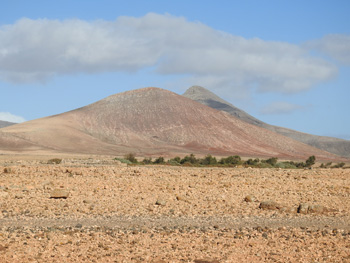 We arrived at La Oliva at 13.30 after a brief lunch break and set off down the track on the left at the end of the town as you head towards El Cotillo and near the 26Km sign (G p28-2: C p128-10) and referred to as Rosa de los Negrines. The track, heading northwest, quickly gives way to a cultivated area with fig trees and palms and eventually leads back to the FV10 close to the town of Lajares. We saw our first rabbit here along with Southern Grey Shrike, Short-toed Lark and Trumpeter Finch. Once back at the FV10 we retraced our steps almost to La Oliva and took a right turn to the protected area known in the site books as La Oliva fence (G p28–2: C p128-8). Driving around the fence and almost returning to La Oliva, before heading along a track to El Cotillo, we saw nothing new. We (sorry I) did get very excited once as we saw several large pale birds in a field behind a nearby farm. Bustard was the thought: Yellow-legged Gull was the reality. My only defence was a trick of the very bright light made the birds seem larger than they actually were!!! We did have excellent close-up views of Kestrel and a pair of Southern Grey Shrike on the tracks near El Cotillo.
We arrived at La Oliva at 13.30 after a brief lunch break and set off down the track on the left at the end of the town as you head towards El Cotillo and near the 26Km sign (G p28-2: C p128-10) and referred to as Rosa de los Negrines. The track, heading northwest, quickly gives way to a cultivated area with fig trees and palms and eventually leads back to the FV10 close to the town of Lajares. We saw our first rabbit here along with Southern Grey Shrike, Short-toed Lark and Trumpeter Finch. Once back at the FV10 we retraced our steps almost to La Oliva and took a right turn to the protected area known in the site books as La Oliva fence (G p28–2: C p128-8). Driving around the fence and almost returning to La Oliva, before heading along a track to El Cotillo, we saw nothing new. We (sorry I) did get very excited once as we saw several large pale birds in a field behind a nearby farm. Bustard was the thought: Yellow-legged Gull was the reality. My only defence was a trick of the very bright light made the birds seem larger than they actually were!!! We did have excellent close-up views of Kestrel and a pair of Southern Grey Shrike on the tracks near El Cotillo.

 Back at the hotel with time to spare before dinner we walked south along the promenade to the spot we had visited late the previous afternoon, halfway between the town and Salinas. Near the hotel we picked up 2 Little Egret, a single Grey Heron and Redshank; moving further along the rocky shoreline we came across 3 Sanderling, a single Whimbrel, Ringed Plover, 3 Kentish Plover and a pair of Grey Plover while upwards of 30 Cory’s Shearwater skimmed the waves just off-shore. In the evening as we walked the short distance to the pool-side restaurant and as we walked up the steps we were greeted by an Algerian Hedgehog as it struggled to descend – big surprise!
Back at the hotel with time to spare before dinner we walked south along the promenade to the spot we had visited late the previous afternoon, halfway between the town and Salinas. Near the hotel we picked up 2 Little Egret, a single Grey Heron and Redshank; moving further along the rocky shoreline we came across 3 Sanderling, a single Whimbrel, Ringed Plover, 3 Kentish Plover and a pair of Grey Plover while upwards of 30 Cory’s Shearwater skimmed the waves just off-shore. In the evening as we walked the short distance to the pool-side restaurant and as we walked up the steps we were greeted by an Algerian Hedgehog as it struggled to descend – big surprise!
Today was probably the warmest day of the trip with temperatures still 24°C in the late afternoon.
Friday 2nd March
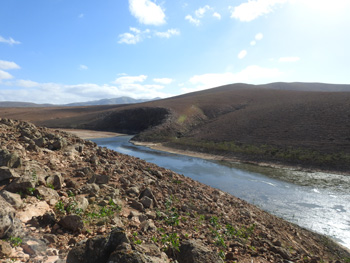 Back to Tindaya and the surrounding plains once again this morning, arriving at 09.45 in search of those elusive desert species, especially the one remaining possible lifer, Cream Coloured Courser. Good views of pairs of Southern Grey Shrike and Egyptian Vulture, but nothing new; in fact very few birds overall, all the way to El Cotillo.
Back to Tindaya and the surrounding plains once again this morning, arriving at 09.45 in search of those elusive desert species, especially the one remaining possible lifer, Cream Coloured Courser. Good views of pairs of Southern Grey Shrike and Egyptian Vulture, but nothing new; in fact very few birds overall, all the way to El Cotillo.
Undeterred, we travelled a little further down the west coast to Los Molinos and the car park of the restaurant El Puertito. We were hoping for a photo opportunity with Fuerteventura Chat but all we saw were 4 Berthelot’s Pipit, the local horde of c20 Muscovy Duck and a few Barbary Ground Squirrel. The waves crashing over the rocks were quite spectacular though.
We arrived at Los Molinos Dam at 13.30. Species seen were similar to those on Tuesday; but in addition we also had single Black-headed Gull, Kentish Plover, Southern Grey Shrike and Hoopoe. The Barbary Falcon and Marbled Duck still lingered, temperatures hovered around 23-24°C and the wind was quite unrelenting.
Saturday 3rd March
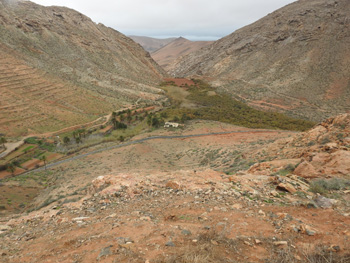 We decided to head for the hills today and visit Betancuria (G p20-4: C p134-1), which, with rain forecast in the morning, was probably a mistake. Joining the FV30 from the FV416 just after Antigua we started to ascend into fairly thick cloud which only thinned out as we descended to the town. We walked for 5 minutes and then the rain started. There was a photogenic Kestrel in the car park, along with a surprising Grey Heron, but little else other than a fleeting Blue Tit. We arrived at 10.00 and left after 20 minutes with the temperature barely reaching 16°C. With the wind and rain persisting there were very few opportunities to stop and look for wildlife. We passed through Vega de Rio Palmas (G p22-5: C p136-1) with no birds in sight, stopped at the Penitas Mirador (G p22-6: C p138-6) for about 30 seconds and was nearly blown away the wind was so strong! The dam below is now permanently dry having silted up.
We decided to head for the hills today and visit Betancuria (G p20-4: C p134-1), which, with rain forecast in the morning, was probably a mistake. Joining the FV30 from the FV416 just after Antigua we started to ascend into fairly thick cloud which only thinned out as we descended to the town. We walked for 5 minutes and then the rain started. There was a photogenic Kestrel in the car park, along with a surprising Grey Heron, but little else other than a fleeting Blue Tit. We arrived at 10.00 and left after 20 minutes with the temperature barely reaching 16°C. With the wind and rain persisting there were very few opportunities to stop and look for wildlife. We passed through Vega de Rio Palmas (G p22-5: C p136-1) with no birds in sight, stopped at the Penitas Mirador (G p22-6: C p138-6) for about 30 seconds and was nearly blown away the wind was so strong! The dam below is now permanently dry having silted up.
When the FV30 returned to the FV20 we decided to head north to La Oliva in search of the elusive desert species as the weather improved. We started off along the track to Rosa de los Negrines and before reaching the buildings with the pigeon loft, we had a fleeting glimpse of a single Barbary Partridge and Berthelot’s Pipit.
 Returning to the main road we carried on towards the coast and El Cotillo: at El Roque we left the FV10 for the numerous tracks to the south of the road, leading to the Tindaya Plain. Here we had super close up views of pairs of Hoopoe and Southern Grey Shrike before continuing along the
coastal track, where, much to our surprise a Houbara Bustard ambled along slowly a few metres from the car. We saw little else as we drove down into the barranco and then out again towards Tindaya. Within less than a kilometre we screeched to a halt seeing a Cream Coloured Courser nearby on the left hand side of the track. The bird picked about a bit on the stunted roadside vegetation and then slowly crossed the road in front of us and continued feeding intermittently on the opposite side of the track. The experience of finding the bird was even better than we had imagined. A pair of Trumpeter Finch, with a really bright male, completed our haul as we prepared to leave the area around 15.30. One final surprise; as we entered Tindaya a lone Cattle Egret scuttled along a low roadside wall – we concluded it was searching for insect or some other suitable food.
Returning to the main road we carried on towards the coast and El Cotillo: at El Roque we left the FV10 for the numerous tracks to the south of the road, leading to the Tindaya Plain. Here we had super close up views of pairs of Hoopoe and Southern Grey Shrike before continuing along the
coastal track, where, much to our surprise a Houbara Bustard ambled along slowly a few metres from the car. We saw little else as we drove down into the barranco and then out again towards Tindaya. Within less than a kilometre we screeched to a halt seeing a Cream Coloured Courser nearby on the left hand side of the track. The bird picked about a bit on the stunted roadside vegetation and then slowly crossed the road in front of us and continued feeding intermittently on the opposite side of the track. The experience of finding the bird was even better than we had imagined. A pair of Trumpeter Finch, with a really bright male, completed our haul as we prepared to leave the area around 15.30. One final surprise; as we entered Tindaya a lone Cattle Egret scuttled along a low roadside wall – we concluded it was searching for insect or some other suitable food.
With the rain well and truly behind us and temperatures reaching 22°C we headed east again to finish the day around the Salinas where a single juvenile Gannet and c20 Cory’s Shearwater flew close to the shoreline and several Whimbrel joined the Sandwich Tern flock. Moving on to the nearby Barranco de la Torre we saw yet another Hoopoe and overhead, a pair of Egyptian Vulture being harried by the local pair of Buzzard. Time for dinner!
Sunday 4th March
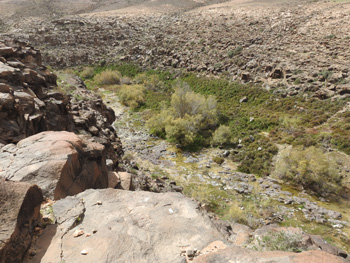 With all of our targets now safely in the bag we decided to revisit the upper Barranco de Rio Cabras and try once again for the Dwarf Bittern. On the way there we stopped by the pool at Altaya de la Rosa del Taro where in addition to the birds seen previously we saw 2 male Mallard, 3 Common Snipe and a single Kestrel. Last time we visited the area we had remained at the top of the cliffs surrounding the dams so we decided to walk the short distance east of the dams to the track leading down to the bottom of the barranco where there is an excellent variety of inviting habitat. Additional species on this visit were hard to come by as there seemed to be fewer birds about than on Thursday. Blue Tit was the only new bird for the site, but a pair of Fuerteventura Chat and a Spectacled Warbler fed nearby with the Chats obviously collecting food before returning to their nest. 4 Little Ringed Plover were also noteworthy. We moved on after about 90 minutes with no sign of the Bittern yet again.
With all of our targets now safely in the bag we decided to revisit the upper Barranco de Rio Cabras and try once again for the Dwarf Bittern. On the way there we stopped by the pool at Altaya de la Rosa del Taro where in addition to the birds seen previously we saw 2 male Mallard, 3 Common Snipe and a single Kestrel. Last time we visited the area we had remained at the top of the cliffs surrounding the dams so we decided to walk the short distance east of the dams to the track leading down to the bottom of the barranco where there is an excellent variety of inviting habitat. Additional species on this visit were hard to come by as there seemed to be fewer birds about than on Thursday. Blue Tit was the only new bird for the site, but a pair of Fuerteventura Chat and a Spectacled Warbler fed nearby with the Chats obviously collecting food before returning to their nest. 4 Little Ringed Plover were also noteworthy. We moved on after about 90 minutes with no sign of the Bittern yet again.

 We stopped for fuel on the way and saw the only Monarch butterfly of the trip fluttering around the vegetation at the side of the Petrol Station. We arrived in La Oliva around noon and decided to drive the road from Lajares to Majanicho on the north coast and then try a track from La Oliva around Montaña de Tindaya. We had read about both of these routes in a recent trip report and thought they could prove worthwhile. The drive through the lava fields to Majanicho was quiet, probably a result of the number of people around on a Sunday! The track in La Oliva is the continuation of Calle Aljibe Blanca, the second left turn after the Disa Petrol Station along the FV10 after the junction with the FV101. Before we left civilisation, a Cattle Egret stood sentry on a low roadside wall. However, although the track seemed to have a lot of potential, the only birds we saw were a few Trumpeter Finch. We followed the track to Tindaya and turned right towards the coast at around 14.45.
We stopped for fuel on the way and saw the only Monarch butterfly of the trip fluttering around the vegetation at the side of the Petrol Station. We arrived in La Oliva around noon and decided to drive the road from Lajares to Majanicho on the north coast and then try a track from La Oliva around Montaña de Tindaya. We had read about both of these routes in a recent trip report and thought they could prove worthwhile. The drive through the lava fields to Majanicho was quiet, probably a result of the number of people around on a Sunday! The track in La Oliva is the continuation of Calle Aljibe Blanca, the second left turn after the Disa Petrol Station along the FV10 after the junction with the FV101. Before we left civilisation, a Cattle Egret stood sentry on a low roadside wall. However, although the track seemed to have a lot of potential, the only birds we saw were a few Trumpeter Finch. We followed the track to Tindaya and turned right towards the coast at around 14.45.
We were hardly out of the town, where the track to El Cotillo crosses the track from Tindaya to the coast (G p28-3) when a Cream Coloured Courser sauntered across the road in front of us. We watched the bird for about 15 minutes as it picked about the stony surface and stunted bushes with a pair of Trumpeter Finch nearby. 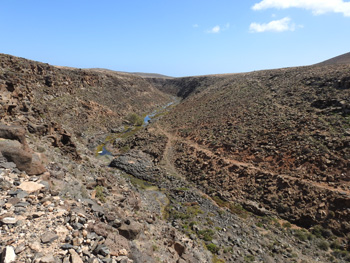 The Courser eventually took flight and a second bird, which had remained unseen, joined it flying to the south. We decided to head off in the same direction, not having been down this track before; no further sign of the Coursers but we briefly saw 6 Black-bellied Sandgrouse heading down a barranco to the coast. As we were leaving Tindaya we saw a single Cattle Egret once again.
The Courser eventually took flight and a second bird, which had remained unseen, joined it flying to the south. We decided to head off in the same direction, not having been down this track before; no further sign of the Coursers but we briefly saw 6 Black-bellied Sandgrouse heading down a barranco to the coast. As we were leaving Tindaya we saw a single Cattle Egret once again.
Before returning to the hotel, we called in at the saltpans where we saw a pair of Common Sandpiper and Ruddy Shelduck with a lone Spotted Redshank, rapidly gaining its breeding plumage. Walking towards the rocky foreshore we spotted c4 Whimbrel as the regular flock of c50 Sandwich Tern loafed on the rocks and c30 Cory’s Shearwater drifted by off-shore.
Monday 5th March
With an afternoon flight home, we decided to head south on the FV2 until it crosses the FV20 & FV4. Turning north on to the FV20 we travelled c6kms to Catalina Garcia (G p22-7), arriving at 10.10 having briefly seen 2 Black-belled Sandgrouse in flight on the journey. The reservoir now appears to be completely silted up, with no sign of water when we were there. The track leading to the reservoir now appears quite rough and we decided not to venture down to the non-existent water. There was a small water-body across the road from the turn off with a single Little Ringed Plover and c6 Yellow-legged Gull in residence.
We didn’t hang around for long and called at Barranco de la Torre which was fairly quiet, apart from a Spectacled Warbler. With the day warming up (23°C), we checked out of our hotel at 11.30 for a final early lunch in Caleta de Fuste. While we were sitting outside at the restaurant a Clouded Yellow floated by along with several Small White butterflies. Time to take the car back to the airport and head back to the freezing UK – joy!
CONCLUSION
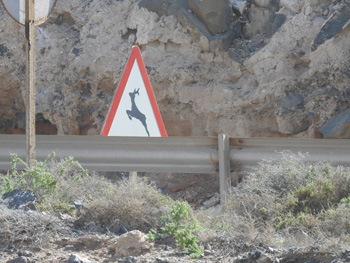 We never expected to see lots of birds and ended up with 60 species, including 7 lifers. We could have tried harder for the Little Bittern, but having seen birds before in Namibia & Tanzania, we decided “life’s too short”!
We never expected to see lots of birds and ended up with 60 species, including 7 lifers. We could have tried harder for the Little Bittern, but having seen birds before in Namibia & Tanzania, we decided “life’s too short”!
All the books and trip reports advise driving slowly and stopping every 500 metres and slowly scanning the stony plains with binoculars when looking for desert species on Fuerteventura. We must have done this for c16 hours whilst there, but never spotted anything interesting: indeed both Bustards and Coursers we saw virtually crossed the road in front of us.
A frequent sight around the island are road signs telling you in picture form to “Beware of the Deer”. Don’t be fooled into keeping your eyes peeled for deer – there are no deer on Fuerteventura. The islanders wanted signs with “Beware of the Goats”; but none were readily available at the right price!
When we arrived on Fuerteventura the landscape was apparently barren, sandy & stony and predominantly brown in colour. After a week and several heavy showers of rain, when we left the hills and surrounding fields were beginning to show green shoots of vegetation, which made the place look very different.
We really enjoyed our week away, but feel we’re unlikely to return: too many places to go and species to see!
Trip List
Fuerteventura Map
Bird Photos
David & Amanda Mason
